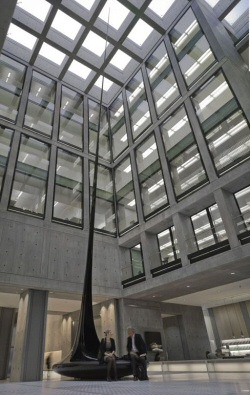Angel Building
Architects
The building design team for the Angel Building in Islington, London, was the practice of Allford Hall Monaghan Morris or better known as AHMM. The architects were commissioned to design the re-invention of a 1980's commercial building that was unsightly, problematic building, which happened to be located on one of London's more notable focal points. AHMM is a practice of architects that believe buildings should be satisfying and enjoyable to use, as well as beautiful to look at. They design very different buildings for different people.
 The team of architects have a logical and open working process that produces intelligent architecture. This facilitates discussion among all parties involved. For over twenty years they have designed architecture that responds to the changes in construction techniques. AHMM designs houses, sports buildings, schools, offices and healthcare facilities and are now building hybrids of several of these. Their work is also international, with projects underway in Amsterdam and Oklahoma City that feature educational, residential and commercial elements.
The team of architects have a logical and open working process that produces intelligent architecture. This facilitates discussion among all parties involved. For over twenty years they have designed architecture that responds to the changes in construction techniques. AHMM designs houses, sports buildings, schools, offices and healthcare facilities and are now building hybrids of several of these. Their work is also international, with projects underway in Amsterdam and Oklahoma City that feature educational, residential and commercial elements.
Design and Structure
The design was developed with several aspirations in mind. The first aspiration was to reintegrate the building with the current pattern of the street by extending and rounding out the corner. Another aspiration was to internalize the unused courtyard by creating an atrium that would be the centre of the building and make the three existing entrances into one single entrance. The design called for a new fifth floor to be added. The result of the design is an essentially new building with more useful space, which retains the structure and just extends the structural frame of the old building. The building was extended at carefully chosen points creating a better fit with the surrounding streets.
The existing frame has been reused and wrapped with an energy efficient glazed skin. The new facade of the building is a high-performance glazed curtain walling system with fins and panels. Large expanses of glass were incorporated into the design to allow for comfort and views of the mature trees. The architecture within the building is designed to emphasise the size and the height of the space. The most important design aspect of the atrium design is controlling the amount of natural light coming from the roof. Early during the design, it was decided that the roof structure would be the main feature of the atrium.
History
In 2007, the Angel Building came into Derwent London's portfolio following the acquisition of the original owner and developer of the property. Derwent London is a large real estate investment trust that has a reputation of for its award winning buildings, quality of management and the ability to identify future growth locations. The building was initially known as the Angel Centre and originally constructed in the 1970's by EPR architects. The building was finished in 1981 and was the office of British Telecom for many decades and they ended their lease and gave up possession in 2006.
The company's exit highlighted numerous troubles with the building, which meant that it would be impossible to find new tenant without a significant investment. To make matters worse the building did not age well at all and was unpopular with the locals, who felt the building reduced the quality and value of the area. After many studies were conducted, a major renovation was started.
Current Use
Currently the newly constructed Angel Building contains approximately 250,000 square feet of beautiful open office space with a cafe, as well as commissioned artwork and large terraces on the roof with spectacular views of London. The building is highly praised for its sustainability, the outdoor space and the brilliant use of light.
The design features make use of biomass for heating and a system for recycled rainwater for use in flushing toilets. This design project shows that it is possible to revamp an unwanted building without resorting to demolition while at the same time taking ecological balance and energy efficiency into account. The building is a great example of how a great design can create places that are good for people, business and the environment.
The closest London Underground Stations to the Angel Building are Angel, Kings Cross, Russell Square, Old Street and Farringdon.
